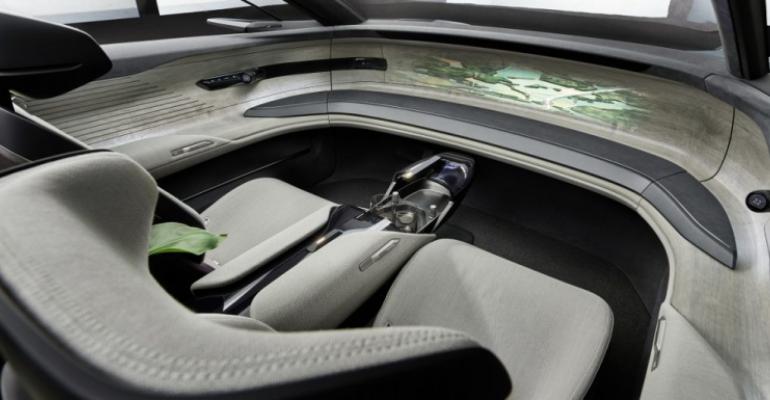Privately owned autonomous cars remain science fiction for the foreseeable future but purpose-built self-driving shuttles and taxis are on the road today.
New design thinking is reinventing their cabin interiors, making them more flexible and comfortable. However, they’ll need clear regulation as to passenger restraints, safety and whether manual controls need to be still included.
“Right now, it’s illegal to have different types of seating but changes in regulation will allow different types of seating configurations. You would be able to build around specific services for passengers,” says Georgios Stathousis, associate director, mobility technology and strategy for FutureBridge, an industry advisory service.
He points to new rules in the US and Germany that do allow specific mobility services like robo-taxis and shuttles to be able to remove steering wheels and poles when they’re not necessary. One challenge will be passenger safety restraint systems, according to Stathousis.
“That’s a technical difficulty but not so far away. It’s more a question of when than can it happen,” he says. Meanwhile, we can fantasize.
Interiors untrammeled
Strategic design consultancy Seymourpowell re-envisioned the ride-hailing vehicle from a personal car pressed into use to the purpose-built Quarter Car. The name comes from its configurability: The interior can be split into four individual (and sellable) seats, or two pairs of seats for people traveling together, thanks to adjustable partitions.
The autonomous concept car includes digital transparent glazing displays and gestural controls, all powered by artificial intelligence. Shared rides reduce energy use and emissions, as well as the number of vehicles on the road, as Jeremy White, Seymourpowell director of transport, points out but, then, there’s the “Uber pool problem.” “People don’t like sharing a vehicle with people they don’t know,” White says.
They can’t be sure who’s going to turn up or in what condition they’ll be, and some people feel vulnerable with strangers. A configurable vehicle also improves the business model, White says. “Instead of selling seats, you start to sell space and an experience. This flexibility enables you to shift what you’re selling.”
Ultimately, self-driving vehicles won’t need steering wheels, pedals or gearshifts at all. That opens up the cabin to all sorts of fun possibilities. “If we don’t need steering controls, that opens up the freedom to be able to have a lounge-type seating area,” Stathousis says. “Passengers can be facing each other.”
Trust signals
Consumer distrust of autonomous vehicles remains high. Today’s drive assistance features focus on making driving easier while minimizing distraction. However, as driving systems move to higher levels of autonomy, drivers must remain in a state of vigilance, according to Chris Rockwell, CEO of Lextant, a user-experience and design consultancy… and, that’s stressful.
Will we be able to truly relax and let the autonomous system take over? “Once you can establish trust, using augmented reality and predictive user-interface design, we can get to a place where people can begin to relax, communicate and collaborate,” Rockwell says. Achieving this will require cabin design that reassures occupants that all systems are working correctly. “There are two things that universally wreck user experience across all domains: ambiguity and unpredictability,” Rockwell says.
Rockwell foresees using AR to bring information about what the vehicle is seeing into the car, so riders can confirm it sees what they do. To reduce the sense of unpredictability, he recommends helping occupants see what the vehicle plans to do next.
“Unless you establish trust, you’ll never be able to accomplish all the other things possible with fully autonomous vehicles,” Rockwell says. Once trust is gained, he adds, the in-cabin experience can focus on wellness, soothing environments, or ones that monitor passengers’ vitals, and maybe adjust accordingly.
Mood lighting
Once passengers have gotten used to trusting their autonomous rides, they can relax. When that happens, cabin lighting can shape different experiences, according to Stathousis. “Lighting plays a big part in the user experience,” he notes. “While now, the use case is primarily illumination, I see it progressing to ambient lighting that can change depending on a passenger’s mood, whether the rider wants to be more relaxed or more aware, for example.” This will be part of an overall shift in the HMI, he thinks. “The HMI will extend to cover everything you touch or see, including visual and touch interfaces,” he says.
Return of the custom car
Maybe vehicle interiors won’t have to be so standardized. Seymourpowell has another concept called Lean. The idea is to start with an electric skateboard chassis that can be used for a variety of interior layouts and body shells.
These could be 3D printed by small custom shops to provide one-off EVs, harking back to the era of hot rods. White says: “The simplicity of EVs could allow for a resurgence of that spirit, things built locally with more for bespoke designs.” Someday, maybe there will be a car for everyone.





